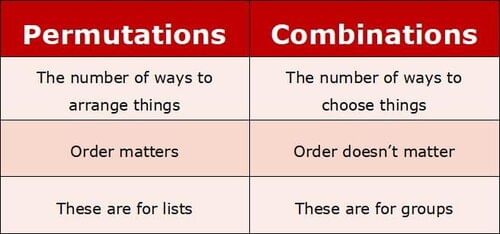|
When choosing three different flavors from five available options, what mathematical concept is used when the order of selection matters? |
Card: 1 / 28 |
|
In the case where repetition of objects is not allowed, the number of permutations is calculated using which expression? |
Card: 5 / 28 |
|
What is the formula for calculating the number of permutations of 'r' objects from 'n' objects? |
Card: 11 / 28 |
|
Fill in the blank: The number of ways to choose 'r' objects from 'n' objects is given by the formula ___, and to find permutations, this must be multiplied by ___ for each combination. |
Card: 13 / 28 |
 Unlock all Flashcards with EduRev Infinity Plan Starting from @ ₹99 only
|
|
What does the Multiplication Principle state regarding the performance of operations? |
Card: 15 / 28 |
|
Operations combine in m×n ways.
|
Card: 16 / 28 |
|
The number of permutations of n different things taken r at a time, allowing repetitions, is given by ___? |
Card: 17 / 28 |
|
Card: 18 / 28 |
|
True or False: The number of permutations of n things taken all at a time, when m specified things never come together, is equal to n! - m! × (n - m + 1)! |
Card: 19 / 28 |
|
What is the formula for dividing 2n different elements into two groups of n objects each when the order of the groups is important? |
Card: 21 / 28 |
|
The coefficient of xⁿ⁻ʳ in the expansion of (1 + x + x² + … + x(k-1))ʳ represents what? |
Card: 23 / 28 |
|
It represents the number of ways of dividing n identical things among r persons such that each person gets 1, 2, 3, …, or k things. |
Card: 24 / 28 |
|
What is the formula for calculating the number of circular permutations of n different things taken all at a time when clockwise and anti-clockwise orders are not considered different? |
Card: 25 / 28 |
|
Fill in the blank: When fixing the position of one object, the number of circular permutations of the remaining objects is ___! |
Card: 27 / 28 |


























